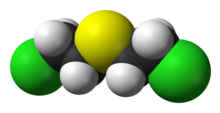
Back Yperiet Afrikaans غاز الخردل Arabic İprit Azerbaijani خردل قازی AZB Іпрыт Byelorussian Іпрыт BE-X-OLD Иприт Bulgarian Iperit Breton Mostassa sulfurada Catalan Yperit Czech

| |

| |

| |
| Names | |
|---|---|
| Preferred IUPAC name
1-Chloro-2-[(2-chloroethyl)sulfanyl]ethane | |
| Other names
Bis(2-chloroethyl) sulfide
HD Iprit Schwefel-LOST Lost Sulfur mustard Senfgas Yellow cross liquid Yperite Distilled mustard Mustard T- mixture 1,1'-thiobis[2-chloroethane] Dichlorodiethyl sulfide | |
| Identifiers | |
3D model (JSmol)
|
|
| 1733595 | |
| ChEBI | |
| ChEMBL | |
| ChemSpider | |
| ECHA InfoCard | 100.209.973 |
| EC Number |
|
| 324535 | |
| KEGG | |
PubChem CID
|
|
| UNII | |
CompTox Dashboard (EPA)
|
|
| |
| |
| Properties | |
| C4H8Cl2S | |
| Molar mass | 159.07 g·mol−1 |
| Appearance | Colorless if pure. Normally ranges from pale yellow to dark brown. Slight garlic or horseradish type odor.[1] |
| Density | 1.27 g/mL, liquid |
| Melting point | 14.45 °C (58.01 °F; 287.60 K) |
| Boiling point | 217 °C (423 °F; 490 K) begins to decompose at 217 °C (423 °F) and boils at 218 °C (424 °F) |
| 7.6 mg/L at 20°C[2] | |
| Solubility | Alcohols, ethers, hydrocarbons, lipids, THF |
| Hazards | |
| Occupational safety and health (OHS/OSH): | |
Main hazards
|
Flammable, toxic, vesicant, carcinogenic, mutagenic |
| GHS labelling:[3] | |
 
| |
| Danger | |
| H300, H310, H315, H319, H330, H335 | |
| P260, P261, P262, P264, P270, P271, P280, P284, P301+P310, P302+P350, P302+P352, P304+P340, P305+P351+P338, P310, P312, P320, P321, P322, P330, P332+P313, P337+P313, P361, P362, P363, P403+P233, P405, P501 | |
| NFPA 704 (fire diamond) | |
| Flash point | 105 °C (221 °F; 378 K) |
| Safety data sheet (SDS) | External MSDS |
| Related compounds | |
Related compounds
|
Nitrogen mustard, Bis(chloroethyl) ether, Chloromethyl methyl sulfide |
Except where otherwise noted, data are given for materials in their standard state (at 25 °C [77 °F], 100 kPa).
| |
Mustard gas or sulfur mustard is any of the several chemical compounds that contain the chemical structure S(CH2CH2Cl)2. In the wider sense, compounds with the substituent S(CH2CH2X)2 and N(CH2CH2X)3 are known as sulfur mustards and nitrogen mustards, respectively, where X = Cl or Br. Such compounds are potent alkylating agents, which can interfere with several biological processes. Also known as mustard agents, this family of compounds are infamous cytotoxins and blister agents with a long history of use as chemical weapons. The name mustard gas is technically incorrect: the substances, when dispersed, are often not gases but a fine mist of liquid droplets.[4] Sulfur mustards are viscous liquids at room temperature and have an odor resembling mustard plants, garlic, or horseradish, hence the name.[4] When pure, they are colorless, but when used in impure forms, such as in warfare, they are usually yellow-brown. Mustard gases form blisters on exposed skin and in the lungs, often resulting in prolonged illness ending in death. The typical mustard gas is the organosulfur compound bis(2-chloroethyl) sulfide.[5]
- ^ FM 3–8 Chemical Reference handbook, US Army, 1967
- ^ Mustard agents: description, physical and chemical properties, mechanism of action, symptoms, antidotes and methods of treatment. Organisation for the Prohibition of Chemical Weapons. Accessed June 8, 2010.
- ^ "Pubchem".
- ^ a b "Mustard Gas" (PDF). ChemMatters. American Chemical Society.
- ^ "What is a Chemical Weapon?". OPCW. Retrieved 2023-09-15.
© MMXXIII Rich X Search. We shall prevail. All rights reserved. Rich X Search
